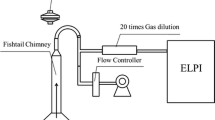Abstract
Agarwood is used as incense around the world. Natural agarwood being in short supply, cultivated agarwood is now produced in many countries, especially in China. Burning agarwood emits fine particulate matter, which enter human lungs and, in turn, elicit illnesses such as cancer. There is actually no knowledge on the differences of hazards posed by the particulate matter released from either cultivated or natural agarwood burning. Here, we measured the diameter and weight of particulates emitted by cultivated and natural agarwood, using an electrical low-pressure impactor. We measured the mutagenicity of particulates using the salmonella reversion test, and the cytotoxicity of each sample of particulates was determined using the 3-[4,5-dimethylthiazol-2-yl]-2,5-diphenyl tetrazolium bromide assay. Results show that more than 99 % of total particles were ultrafine and fine particles. The cultivated agarwoods emitted a higher proportion of ultrafine particles than the natural agarwoods. The smoke produced by the cultivated agarwood was more mutagenic and more cytotoxic than natural agarwood.

Similar content being viewed by others
References
Akter S, Islam MT, Zulkefeli M, Khan SI (2013) Agarwood production—a multidisciplinary field to be explored in Bangladesh. Int J Pharm Life Sci 2:22–32
Barden A, Anak NA, Mulliken T, Song M (2000) Heart of the matter: agarwood use and trade and CITES implementation for Aquilaria malaccensis. Traffic Netw Rep 46:17–18. https://portals.iucn.org/library/sites/library/files/documents/Traf-072.pdf. Accessed 27 Nov 2015
Bitterle E, Karg E, Schroeppel A, Kreyling WG, Tippe A, Ferron GA, Schmid O, Heyder J, Maier KL, Hofer T (2006) Dose-controlled exposure of A549 epithelial cells at the air–liquid interface to airborne ultrafine carbonaceous particles. Chemosphere 65:1784–1790
Blanchette RA, van Beek HH (2009) Cultivated agarwood. US Patent 7,638,145 B2, 29 Dec 2009
Brouwer DH, Gijsbers JHJ, Lurvink MWM (2004) Personal exposure to ultrafine particles in the workplace: exploring sampling techniques and strategies. Ann Occup Hyg 48:439–453
Chakrabarty K, Kumar A, Menon V (1994) Trade in Agarwood. TRAFFIC India and WWF-India, New Delhi
Chang HJ, Kuo ML, Lin JM (1997) Mutagenic activity of incense smoke in comparison to formaldehyde and acetaldehyde in Salmonella typhimurium. Bull Environ Contam Toxicol 58:394–401
Chen HQ, Yang Y, Xue J, Wei JH, Zhang Z, Chen HJ (2011) Comparison of compositions and antimicrobial activities of essential oils from chemically stimulated agarwood, wild agarwood and healthy Aquilaria sinensis (Lour.) Gilg Trees. Molecules 16:4884–4896
Chuang HC, Jones T, Chen TT, BéruBé K (2013) Cytotoxic effects of incense particles in relation to oxidative stress, the cell cycle and F-actin assembly. Toxicol Lett 220:229–237
Hakura A, Shimada H, Nakajima M, Sui H, Kitamoto S, Suzuki S, Satoh T (2005) Salmonella/human S9 mutagenicity test: a collaborative study with 58 compounds. Mutagenesis 20:217–228
Hilton-Taylor C (2000) 2000 IUCN red list of threatened species. IUCN, Gland
Liou SW, Chen CY, Yang TT, Lin JM (2008) Determination of particulate-bound formaldehyde from burning incense by solid phase microextraction. Bull Environ Contam Toxicol 80:324–328
Liu YY, Chen HQ, Yang Y et al (2013) Whole-tree agarwood-inducing technique: an efficient novel technique for producing high-quality agarwood in cultivated aquilaria sinensis trees. Molecules 18:3086–3106
Maron DM, Ames BN (1983) Revised methods for the Salmonella mutagenicity test. Mutat Res 113:173–215
Mohd MF, Mohd RY, Lim HF, Alias R (2010) Costs and benefits analysis of Aquilaria species on plantation for agarwood production in Malaysia. Int J Bus Soc Sci 1:162–174
Mossmann T (1983) Rapid colorimetric assay for cellular growth and survival: application to proliferation and cytotoxicity assays. J Immunol Meth 65:55–63
OECD (1997) OECD guideline for the testing of chemicals, section 4, test no. 471: bacterial reverse mutation test. http://www.oecd-ilibrary.org/docserver/download/9747101e.pdf. Accessed 27 Nov 2015
Okudera Y, Ito M (2009) Production of agarwood fragrant constituents in Aquilaria calli and cell suspension cultures. Plant Biotechnol 26:307–315
Rasmussen RE (1987) Mutagenic activity of incense smoke in Salmonella typhimurium. Bull Environ Contam Toxicol 38:827–833
Shah AB, Combes RD, Rowland IR (1990) Activation and detoxification of 1,8-dinitropyrene by mammalian hepatic fractions in the Salmonella mutagenicity assay. Mutagenesis 5:45–49
Ulukaya E, Ozdikicioglu F, Oral AY, Demirci M (2008) The MTT assay yields a relatively lower result of growth inhibition than the ATP assay depending on the chemotherapeutic drugs tested. Toxicol In Vitro 22:232–239
Wichmann HE, Spix C, Tuch T et al (2000) Daily mortality and fine and ultrafine particles in erfurt, Germany: part i: role of particle number and particle mass. Research Report 98:5–86; discussion 87–94
Zenzen V, Diekmann J, Gerstenberg B et al (2012) Reduced exposure evaluation of an electrically heated cigarette smoking system. Part 2: Smoke chemistry and in vitro toxicological evaluation using smoking regimens reflecting human puffing behavior. Regul Toxicol Pharmacol 64:11–34
Zhou R, An Q, Pan XW, Yang B, Hu J, Wang YH (2015) Higher cytotoxicity and genotoxicity of burning incense than cigarette. Environ Chem Lett 13:465–471
Acknowledgments
Professor Andrew Sinclair, Deakin University, Australia is thanked for his editing of the manuscript.
Author information
Authors and Affiliations
Corresponding authors
Rights and permissions
About this article
Cite this article
Zhou, R., Yang, B. & Wang, Y.H. Higher cytotoxicity and genotoxicity of cultivated versus natural agarwood incense smoke. Environ Chem Lett 14, 501–506 (2016). https://doi.org/10.1007/s10311-016-0567-1
Received:
Accepted:
Published:
Issue Date:
DOI: https://doi.org/10.1007/s10311-016-0567-1




